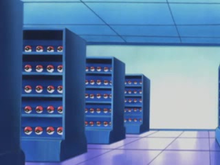Science and Pokémon: A Good Catch
|
Your pulse quickens. Every muscle in your body tenses as you stare at the red and white sphere, watching it shift side to side in an almost hypnotic rhythm. The seconds pass like hours, unbearable as you await the ball's verdict.
And finally... ding.
Your hands drop to your side and a wave of relief washes over you. Your companion smiles up at you and you smile back. Congratulations, you've just caught a new Pokémon!
A Poké Ball is a common tool utilized by Trainers, Professors, Breeders and every other kind of Pokémon professional in the Pokémon world. Without it, people would be unable to capture and carry Pokémon conveniently. It is thanks to this technology that Pokémon journeys are even possible.
So what exactly does a Poké Ball do?
The Poké Ball has many features including the ability to change size and the ability to be transferred instantaneously from one location to another. However, we shall focus on its primary function; that is, to capture and store Pokémon. How does a Poké Ball accomplish this simple, yet complicated feat?
Matter storage
Poké Balls store Pokémon through mass-energy equivalence. A Pokémon's material is, theoretically, transformed into a form of energy, which is kept in the sphere's hardware.
That's not necessarily true. It is impossible to "convert" mass to energy or energy to mass due to conservation laws regarding both. Rather, a mass has some form of energy and energy must exist in some form of mass. They are partners in the grand scheme of the universe as demonstrated by Einstein's E=mc2 or Energy = mass x (speed of light)2.
Realistically, when returning to a Poké Ball, the Pokémon undergoes some form of conversion that relates to the translation of its mass and energy. Every mass, including a Pokémon, has an internal energy such as the heat within its body, chemical compounds, electrical neural impulses, etc. The Poké Ball, rather than transforming all of the mass to energy, merely converts both into forms it can handle.
Think of it this way. Imagine that you have several pieces of paper and you crumpled it together to about the shape of a baseball. Yet, no matter how much paper you use, the paper ball is still lighter (and has less mass) than the baseball. In other words, the baseball and the paper ball may be the same size, but the baseball has a lot more mass in it. The baseball is denser.
This may sound a bit brutal, but the mass of a Pokémon is similarly placed into an extremely small volume, and thus its density increases. It is scientifically compacted into a small size by changing its molecular structure.
Of course, the Pokémon itself doesn't feel any pain. We'd have known if it did.
Pattern storage
The most critical process of a Poké Ball is pattern storage. The Poké Ball must record and accurately remember the proper placement of every atom within a Pokémon's body. For perspective, a 70 kg human adult has 7×1027 atoms or 7 followed by 27 zeroes.
That's a lot of information.
However, to properly ensure that all critical components of a Pokémon are stored, it probably needs to remember every particle at the quantum level. That's 2×1045 bits of information. For reference, a single terabyte (1024 gigabytes) can only store 8.80×1012 bits of information.
In other words, we'd need a quadrillion times the space of a terabyte drive to store the atomic information of a Pokémon and many times more that for quantum level storage. And that's not even considering the space needed for any backups that might be created in case of device failure. Or the fact that some Pokémon are many times larger than your average human.
It's at this point that we realize that the Pokémon world must be decades, if not centuries, ahead of our world in terms of computer technology and miniaturization. Especially if you consider the fact that any 10-year-old can buy a Poké Ball from the local Poké Mart for essentially what amounts to pocket change.
Fail to safe
The Poké Ball must accurately remember the pattern, or else the results could be disastrous. The loss of even a single percentage of data could result in the loss of a Pokémon's foot or tail. Lose certain critical bits and you might release not your friend and companion but a massive pile of Pokesludge, a mutated creature or its dead body. How terrible it would be to cradle your starter in your arms as its life fades away because it materialized without a heart.
These are nightmare scenarios.
Luckily, Poké Balls are built with redundant systems and designed to "fail to safe". It's the same reason why your smoke detector goes off when the batteries are low, even if there isn't a fire. It alerts you that the batteries need to be changed. If it failed without making that noise, it wouldn't be able to bleep loudly when there is an actual fire. It's designed to fail in a way that won't harm the user.
Most products are designed in a way to meet or exceed safety regulations if the failure could be catastrophic. For example, you have a much lower chance of dying while flying on a plane than driving a car. That's because a plane crash tends to grab many more headlines than a car crash. Thus they are designed to be safer.
I doubt Silph Co. would want reports of dying Pokémon hitting the front pages.
Poké Balls are likely constructed to fail to safe before they fail catastrophically. Backups of the patterns are created and regularly checked against each other to ensure none of them have corrupted. In the case of Poké Ball damage, a Poké Ball is designed to either release the Pokémon immediately before further systems fail or to "lock down" and direct all its resources to saving the Pokémon's pattern until it can be repaired. Damaged empty Poké Balls will not function in terms of capturing or recalling Pokémon. It's safer for the Pokémon to stay outside of the ball than to be placed in a damaged sphere.
As we've seen, the Poké Ball's outer shell is rather tough. Logically so, as it must withstand the constant beating it takes being thrown every way past Sunday. Likely this shell is not only composed of some sturdy metal, but must utilize a dampening method to prevent the destructive forces from damaging the inner machinery. This is similar to the concept of shock absorbers. The outside may bounce around, but the forces are reduced inside.
Pokémon themselves are aware of their surroundings and able to leave their Poké Balls. During the Diglett episode, Pokémon didn't leave their Poké Balls because they didn't want to fight. To have made that decision, they must have been aware of the world outside of the Poké Ball. Misty's Psyduck, among others, has demonstrated that Pokémon are capable of escape, even if they weren't sent out by their Trainers. Thus Pokémon have control over their own safety and may leave the Poké Ball any time they feel threatened.
All of this adds up to a system with many built-in redundancies to ensure that what you call from your Poké Ball is what went into it.
Materialization
Finally, the Poké Ball must be able to "release" the Pokémon.
The actual process is more "materialization" than "release". Essentially, the Poké Ball reconstitutes the stored matter and energy based on the pattern in its memory banks. It's a complicated process that today's science cannot even begin to explain. It can best be equated to putting together a puzzle, but you know where each and every piece goes. The computerized/mechanical system of the Poké Ball speeds this process up by thousands of times.
The materialization system itself likely needs energy to run, and it probably would be best for it to not use the energy of the Pokémon itself (for the nightmarish reasons mentioned above). Thus, it likely has its own energy source in the form of some sort of battery.
Given that the world's technology is so advanced, I wouldn't be surprised if it used a powerful storage method. Perhaps Poké Balls runs off of an efficient solar panel method or is recharged whenever brought to a Pokémon center. Whatever the case, it must store enough energy to allow for the return and release of Pokémon multiple times a day.
And if it runs out of power, it probably fails to safe by releasing the Pokémon from the Poké Ball before the battery dies completely.
Things to think about
The Poké Ball is a complicated machine that allows us to conveniently catch and carry Pokémon. It is a testament to the Pokémon world's technology that it functions at all and doesn't result in terrible failures.
However, we've only scratched the surface of the Poké Ball. What does a Pokémon feel or see when it's within a Poké Ball? Does the Poké Ball change the nature or attitude of the Pokémon towards the Trainer who captured it? What about Apricorns or ancient capturing vessels as seen in the anime?
Mysteries to be solved another time.




